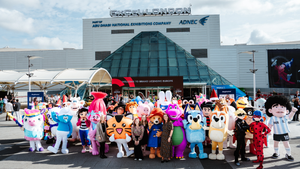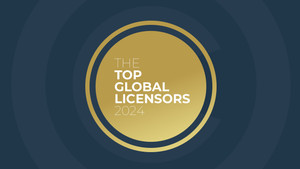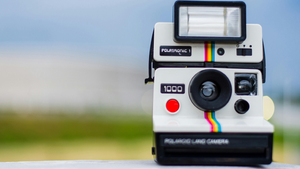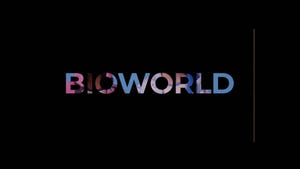Playboy and The Year of The Rabbit
Described as “the original lifestyle brand” with a logo recognized around the world, Playboy is celebrating its 70th anniversary this year. Here, we look into its recent rebrand and how its transitions over the years have helped the brand continue to stay relevant.
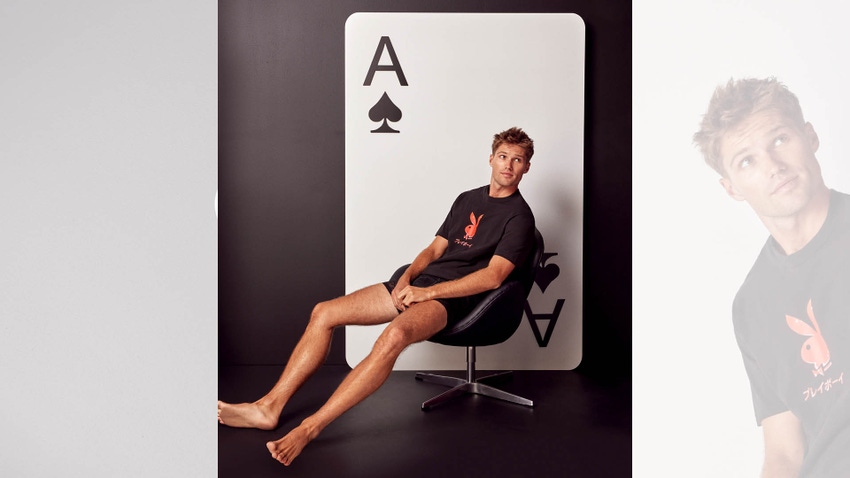
At a Glance
- Transforming from a men’s lifestyle and entertainment magazine to a global lifestyle brand.
- Rebranding to explore new sectors and territories.
- 70th anniversary celebrations.
Starting out as a men’s lifestyle and entertainment magazine in print back in 1953, Playboy is now a global lifestyle brand. It continues to reach a broad audience through its diverse portfolio of licensed consumer products and experiences, including apparel, accessories, lingerie, footwear, furniture, jewelry, fragrance and beauty, personal care, international media, gaming and location-based entertainment.
No longer a print publication (the company stopped the press and published its final issue in March 2020), Playboy is now established as a digital-first business. It has been going through a rapid period of transformation, becoming a publicly-traded company the following year. Playboy Enterprises is ranked No. 21 on License Global’s Top Global Licensors Report, with an estimated $3 billion in retail sales.
“Playboy is bigger today than ever before because we stand for important social issues relating to freedom of expression, inclusivity, sex positivity and discovery,” says Allison Kopcha, chief business development officer and licensing, PLBY Group. “Coupling this with our iconic lifestyle brand and relevant products and experiences really resonates with millennial and Gen Z audiences.”
Today, the brand is focused on its main business goals: direct-to-consumer, owning and operating consumer product categories and being a cohesive and relevant lifestyle brand for consumers. These goals help the brand to branch out into new apparel categories. In November, for instance, PLBY Group launched Playboy Lingerie, its first owned-and-operated lingerie brand.
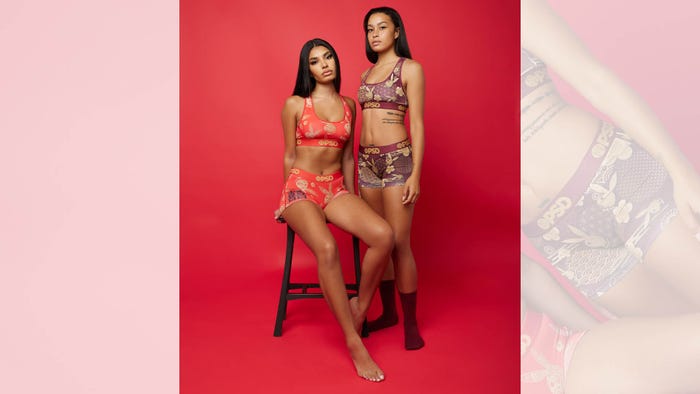
Playboy x PSD intimates collection.
“We are constantly ideating on new collaborations and product offerings across the Playboy ecosystem,” says Kopcha. “In 2022, we launched everything from earrings with Studs and streetwear with OVO to an ultra-premium bourbon through our spirits brand, Rare Hare, and we continue to work with anchor collaboration partners, including PacSun and PSD, and new premium collaborations with Saint Laurent.”
Of course, with evolution comes challenges that need to be addressed.
“We are no longer a media company – we are a life-style business that rallies a community around a shared mindset and way of living,” Kopcha continues. “We are in the business of creating culture, not following it, and we do so through unique Playboy-branded experiences, content and products.”
Lifestyle and culture have always been at the forefront of Playboy’s focus. The Playboy Club, a chain of nightclubs and resorts, owned, operated and franchised by Playboy Enterprises, first opened in Chicago in 1960. The clubs hosted entertainers – one of the first acts was Aretha Franklin (her first professional engagement, playing piano and singing, for $250 a week).
Playboy is no stranger to change and its ability to rebrand and explore new sectors and territories is one of the keys to its success and longevity.
“Category expansion has been an important business driver to engaging consumers at retail,” says Kopcha. “Successful collaborations are based on shared brand values, serving a similar audience. We work closely with all partners to bring the Playboy brand to life in exciting new ways ranging from ‘must attend’ piercing events with Studs at its LA store to a tasting event with our new partner Tipsy Scoop. In Korea, our new partner Peaches transformed its retail store into a co-branded, sophisticated social club, where consumers can shop and experience the brand.”
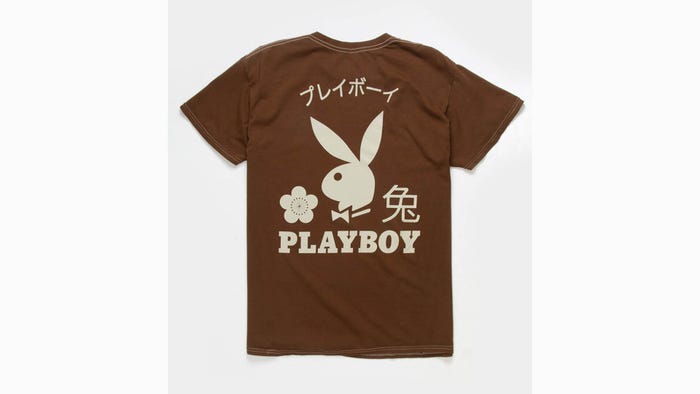
Merch Traffic’s line of Playboy T-shirts.
The Birth of an Iconic Logo
The mascot, now synonymous with Playboy, was created as an endnote by art director, Art Paul, for the second issue. The stylized silhouette of a rabbit wearing a tuxedo bow tie was adopted as the official logo soon after. While the rabbit may have been a fixture since Playboy’s early days, one of the biggest changes has been the brand’s consumer base, which has swung dramatically, meaning the brand now works with content creators in new ways through its digital platforms. In 2021, Playboy named rapper, Cardi B., as its creative director for its new creator platform.
“When we ceased publication of the magazine, our audience changed,” adds Kopcha. “Today, our primary consumer products customers are female and male under the age of 34. As a brand, we have been committed to core values of freedom of expression, sex positivity and serving as a platform for creative voices and a new generation of confident content creators. We are constantly asking ourselves what it means to stand for these things in 2023 and beyond, and how we can continue to drive culture forward. As a business, we believe strongly in inclusion for all regardless of age, race, size, gender identity and sexual orientation. Our customer sees this in the reimagined brand of today.”
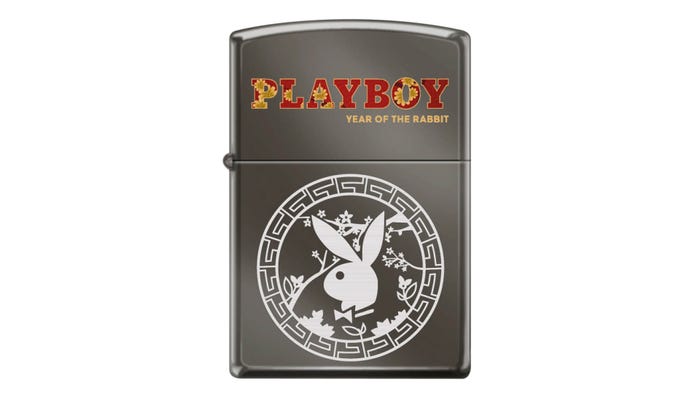
The Zippo line of Playboy Year of the Rabbit lighters.
Playboy 70th Anniversary Celebrations
Playboy was first published on Dec. 1, 1953, and its 70-year-anniversary celebrations are a big focus toward the back end of 2023 as it builds up to the milestone. The irony is not lost, on a company that prides itself on its iconic rabbit head logo, that the anniversary also coincides with the Chinese lunar calendar and the Year of the Rabbit.
“What could be more fortuitous than kicking off our 70th anniversary year in the Year of the Rabbit?” asks Kopcha. “Our global licensing agency, CAA Brand Management, has developed a colorful and creative 70th anniversary style guide and we are seeing celebratory products from licensees worldwide including Zippo, Lids for the U.S. and international, Atomic in Australia, Leather Protector in Malaysia, Jean Center for LATAM and The Noble Sculpture, a new collaboration partner in India, to name a few. The business is also exploring other ‘celebrations of the senses’ across art, music and experiences, which will launch later this year.”
The Year of the Rabbit has already created a buzz in fashion, with Burberry, Nike, Ferragamo, Gucci and Prada all releasing collections inspired by the creature which, in China, is a symbol of longevity and peace.
With a significant portion of its business and consumer base located in China, it’s an opportunity for collaborations that’s just too good to miss for Playboy.
This article was taken from February's issue of License Global, which you can read in full here.
Read more about:
PlayboyAbout the Author(s)
You May Also Like


